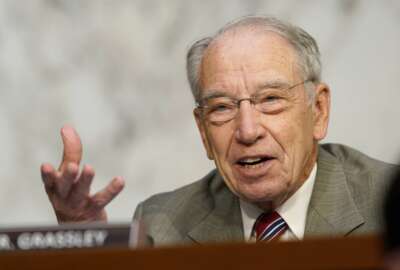Hubbard Radio Washington DC, LLC. All rights reserved. This website is not intended for users located within the European Economic Area.
On Air: Federal News Network
Trending:
Small business contracting goal remains elusive
The Obama administration has pushed agencies to increase contracting opportunities with small business, most notably creating a governmentwide task force to s...
wfedstaff | April 17, 2015 4:08 pm

The Obama administration has pushed agencies to increase contracting opportunities with small businesses, most notably creating a governmentwide task force to share best practices.Yet the federal government, as a whole, has continued to miss its 23 percent small business contracting goal.
In fiscal 2011, federal agencies spent $91.5 billion on small business contracts but were still $5.4 billion short, reaching 21.7 percent of the 23 percent goal. It was the sixth year in a row the government missed the mark.
| Why small business contracting was rated ineffective |
| Reason #1: Agencies fail to meet the 23 percent small businesses goal for the sixth year in a row
Reason #2: Agencies aren’t complying with the law, which requires that purchases or service contracts worth less than $150,000 go to small businesses Reason #3: Agencies did not meet set-aside goals such as those for women- and service-disabled veteran-owned businesses (More primary source material available on The Obama Impact Resource Page) |
In addition to the overall 23 percent small business goal, agencies have other targets they are asked to reach. Five percent of that 23 percent is supposed to go to women-owned businesses, 3 percent to service-disabled veteran-owned businesses, 3 percent to Historically Underutilized Business Zones (HUBZone), and 5 percent to small disadvantaged businesses (SDB). The government only met one of those goals in 2011 — awarding SDBs 7.67 percent, or $32.4 billion, of government contracts.
For these reasons, Federal News Radio rates the Obama administration’s impact on small business contracting as ineffective. The rating is part of our special week-long, multimedia series, The Obama Impact: Evaluating the Last Four Years. Throughout the series, Federal News Radio examines 23 different ideas and initiatives instituted by the Obama Administration and ranks them as effective, ineffective or more progress needed.
|
|
| “When there are a bunch of small funding periods [it] tends to prevent agencies from doing all of the acquisition forecasting that they need. ” |
| — Joe Jordan, Office of Federal Procurement Policy |
|
|
Budget pressures
Tight budgets and questions about agency funding levels may be one explanation for the shortfalls, according to administration officials.
“Obviously, 2011 presented some headwinds,” said John Shoraka, SBA’s associate administrator of government contracting and business development. “We had a continuing resolution that extended through the first three quarters of the year. That brings a lot of uncertainty and ambiguity to contracting officers. And when that happens, that can hurt a lot of small business contracting opportunities in federal procurement.”
Joe Jordan, administrator of the Office of Federal Procurement Policy, also pointed to uncertain budgets as one reason for the missed goal.
“When there are a bunch of small funding periods, [it] tends to prevent agencies from doing all of the acquisition forecasting that they need,” Jordan said. “As we look forward, we have to take that as somewhat of a reality and make sure we’re working with agencies, even in continuing resolutions and not full-year authorization bills, that they’re doing that planning, that they’re thinking about, ‘Hey, these are contracts that are going out no matter what and let’s make sure these get in the hands of a small business.'”
There is a “grain of truth” that tight budgets can squeeze small firms out of government contracts, said Steven Koprince, a government contracts attorney and partner at Petefish, Immel, Heeb & Hird LLP.
“For instance, instead of setting aside two contracts for small businesses, it might be more advantageous from an administrative perspective to simply issue one larger unrestricted. That sort of thing may indirectly lead to fewer small businesses receiving awards,” Koprince said.
But Koprince added that budgets alone do not entirely explain the missed goals.
Accountability
A bigger challenge to meeting the 23 percent goal is that while it has been mandated by Congressional legislation, there are no penalties for agencies that don’t hit the target.
|
|
| “There is no accountability. Period.” |
| — Cris Young, American Small Business Chamber of Commerce |
|
|
“There is no accountability. Period,” said Cris Young, president of the American Small Business Chamber of Commerce.
Koprince agreed, saying, the SBA may “wag its finger” at an agency, but there are “no teeth” behind the goal.
Young said the lack of accountability shows a lack of real commitment to contracting with small businesses.
“If the President was sincerely committed to meeting these goals, we’d be seeing total alarm and total commitment — presidential mandates and action. Instead, what we have is the herding of small businesses into promotional events,” she said.
The Obama administration has made some efforts to increase accountability. One of the recommendations to come out of the White House Small Business Procurement Group was to tie the goals to senior executives’ performance reviews.
It’s one of the reasons the Environmental Protection Agency has been able to hit its goal of awarding 42 percent of its contracts to small businesses, said Jeanette Brown, director of the agency’s Office of Small and Disadvantaged Business Utilization (OSDBU).
“For some of the managers, if they’re not seen doing something there [for small business contracting], it’s tied to their bonuses,” she said.
Even without incorporating the small business goals into performance evaluations, just the existence of the White House Small Business Procurement Group holds agencies accountable to their small business goals, Jordan said.
“We bring the deputies to the White House quarterly to talk to the senior White House officials, not just about the policies, although that’s critically important, but to ask, ‘Hey, how’s your agency doing against your goals?’ What I’ve found is, just asking that question drives improvements in results because then that [deputy secretary] is going to the agency and saying to their senior procurement exec, ‘Hey, how are we doing with the goal?’ and then the senior procurement exec is going to all the heads of the contracting activities and saying, ‘How are we doing against our goals?'” Jordan said. “Well, nobody wants to report up the chain bad news.”
|
More contracting tools The Small Business Jobs Act, signed into law by President Barack Obama in September 2010, added and clarified some of the small business contracting tools available to agencies.
The act allowed contracting officers to use small business set-aside contracts on task orders of multiple-award contracts, including the Federal Supply Schedule. Before the law, small businesses had to compete with large firms as well for task orders.
The act also reaffirmed parity among the small business contracting programs so that contracting officers can choose from any of the programs to award a set-aside.
|
|
| “If you’re buried within the organization, you’re not going to be effective, I can assure you.” |
| — Mauricio Vera, USAID OSDBU |
|
|
For a long time, confusion around these policies were “impediments” to meeting the small business goal, Jordan said.
“Whenever there’s confusion, it tends to be a disincentive for contracting officers to act in the way we would like them to. Getting rid of confusion around these policies has been helpful,” Jordan said.
In June, SBA and the Office of Federal Procurement Policy sent a memo to agencies reminding them all purchases under the simplified acquisition threshold — usually $150,000 — must be set aside for small businesses by law. An analysis found “a significant amount of work” under simplified acquisition was not going to small businesses, the memo said.
But it’s not clear to what extent agencies are using these contracting options. Despite the administration’s push for open data — not all of the details of how agencies contract with small businesses is readily available online.
SBA launched a small business contracting dashboard in 2010, a directive from the President’s memo that created the interagency task force. Data comes from the Federal Procurement Data System (FPDS), which collects all of the government’s procurement data. The dashboard breaks down spending by small business type and agency. But the data does not specify the type of contracts, the number of small firms agencies contract with, the number of small firms that bid for contracts or other “real pertinent information,” said Young, of the American Small Business Chamber of Commerce.
SBA’s Shoraka said FPDS goes as far as to show which contracts in a multiple award contract go to small businesses, but the data available now does not indicate whether those small business contracts came from a set-aside or simply went to a small business.
“That’s something we’re working to make sure that field is added, so as we move into 2013, we’ll have the ability to see if it was set aside,” Shoraka said.
Role of the OSDBU
The Small Business Act required all agencies have an advocate for small businesses with the creation of the Office of Small and Disadvantaged Business Utilization. The OSDBU is supposed to report directly to the deputy director. However, not all agencies have been in compliance with this reporting requirement. A June 2011 report found seven of 16 agencies reviewed were not in compliance.
“If the agency does not put you at that level, then they’re basically stating that small business is not that important,” said Mauricio Vera, the OSDBU at USAID.
|
|
| “It’s daunting for a new firm, but at the same time, many of them are excited to learn and find out more about how to do business with the federal government.” |
| — Jeanette Brown, EPA OSDBU |
|
|
Vera attends senior-level meetings several times a week and is at the same level as the senior procurement executive. This year, he started a one-day small business contracting training course required for all contracting staff and technical representatives. Part of the training is to urge staff to contact the small business office early on in the acquisition process.
“If you’re buried within the organization, you’re not going to be effective, I can assure you. It makes a big difference, the reporting [requirement],” Vera said.
Vera said the White House task force further elevated the role of the OSDBU and raises the visibility of the small business program.
“I think the first time our deputy administrator went over there, he thought, ‘Hmm, maybe our numbers weren’t so great.’ So he went back and said, ‘How do we improve on that?’ We came up with a strategy that really raised the visibility of the program and did some things internally, like the training,” Vera said.
Outreach to small businesses
Part of the government’s challenge in contracting with small businesses is attracting qualified firms in the first place.
SBA has an online resource called Government Contracting Classroom that offers explanations of the various set-aside programs, as well as online training sessions.
The EPA has taken a proactive approach to educating potential contractors, particularly HUBZone businesses. In April, the agency partnered with a HUBZone organization to hold an event in Chicago. EPA also regularly holds counseling sessions every month, as well as informal “brown bag” meetings with up to 10 firms at a time, said EPA’s Brown.
“It’s daunting for a new firm, but at the same time, many of them are excited to learn and find out how to do business with the federal government,” Brown said.
More from the special report, The Obama Impact: Evaluating the Last Four Years
Part 1: Evaluating the Obama administration’s management initiatives
Part 2: Evaluating Obama’s technology reforms
Part 3: Evaluating Obama’s workforce initiatives
Part 4: Evaluating Obama’s acquisition efforts
Part 5A: What would a second-term for President Obama mean for feds?
Part 5B: What would a Romney presidency mean for federal workers?
Copyright © 2024 Federal News Network. All rights reserved. This website is not intended for users located within the European Economic Area.




